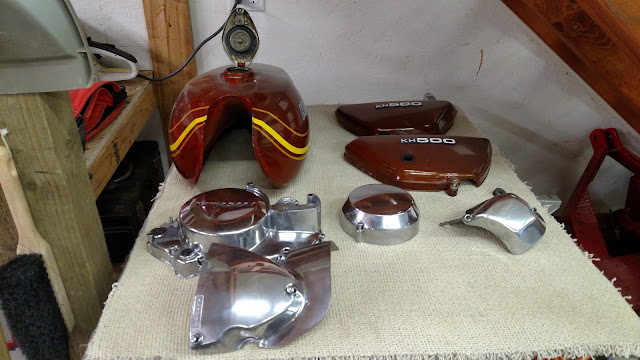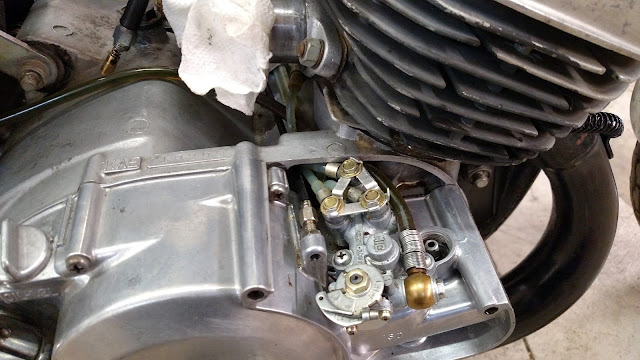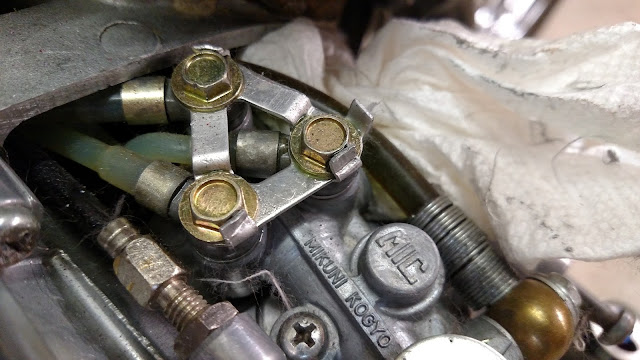Damaged clutch cover. The oil injector pump is forward of the 2:00 position on the cover.
Partway cleaned up, below.
Not perfect, but much better! This is as much effort as I am willing to put into this part. I've got about an hour into this one piece.
All the shiny parts...
Note the repair area on the clutch cover has a shiny arc on it (just above the bottom bead of the weld). That's where the clutch rubs on the repair when it is fully disengaged. The clutch has always required careful adjustment so that it disengages, but doesn't rub. I think I will get out the Dremel and clean this up a bit. Perhaps I can get a little more room on the clutch adjustment.
Off road two-stroke bikes use a fuel premix; that is the owner mixes fuel with two-stroke oil in a 40:1 ratio, and pours that blend into the fuel tank. I do the same with my weedwhacker and chainsaw.
Two stroke street bikes were always (as far as I know), equipped with a dedicated oil injection system, complete with reservior and injector pumps, rather than running premix. Some owners ditched the injection system and ran premix to shed a few pounds.
Oil injection has a couple of advantages and one big disadvantage. One, it's nice to fuel up your bike without having to stop fueling at a certain point and add oil to ensure you have the correct gas/oil ratio - The injection pump takes care of that for you. Secondly, the reservior holds quite a bit of oil, so you don't have to even worry about oil often - maybe every 5th tank of gas.
The disadvantage (and it's a big one) is that the oil injection pump increases oil flow based on throttle position. Most times, that works well. However, if you have been running the engine wide open and still have a lot of revs on it, and let off the throttle, well, the pump quits pumping so much oil while your engine still has lots of RPMs. That's not so great.
Below, the oil reservoir. There is a little cup with a mesh screen that screws onto the bottom. It has a nipple to which the tubing with the green oil flows over to the injector pump. The reservior has since been removed and cleaned out. The filter screen had a layer of gummy slime on it that would certainly have starved the engine of oil.
Below, the Mikuni oil injection pump. The brass fitting is where the oil from the reservior feeds the pump. The rotating assembly at the bottom (with markings) is how the throttle cable increases the swept volume of the pump. The triangular arrangement with the bolts is the pump discharge. Each nylon line goes to one cylinder to lubricate it. After entering the engine block, part of the oil goes to the main bearing, and part goes to the inlet to be blended with fuel/air mixture to lubricate the piston and piston wrist pins. The drive for the tachometer cable is just above the brass fitting.
Found the oil leak after all these years! The right bolt on the triangle has some green oil around it.
Here I have removed the clutch cover and the oil pump. The left shaft is for the kick-starter. The clutch basket is at center, and the crankshaft is to the right. This portion of the engine is normally full of 10W-30 motor oil, because this is a wet clutch and the gears require oil.
Brake pedal and footrests after being hit with a wire wheel.
left to right, clutch oil level dipstick, oil pump, oil supply line with filter cup attached and plugged. Screwdriver. Tach and speedo cables at top. Kickstart lever, gear shift lever, gas tank stuff.
Left side of the bike. Output shaft and sprocket, shift lever (overly complex, and has too much play), Alternator/ignition cover at left. Above that, one of the oil lines from the injection pump where the oil enters the engine block. Top right: The nasty corroded battery box and electrical bits.














No comments:
Post a Comment